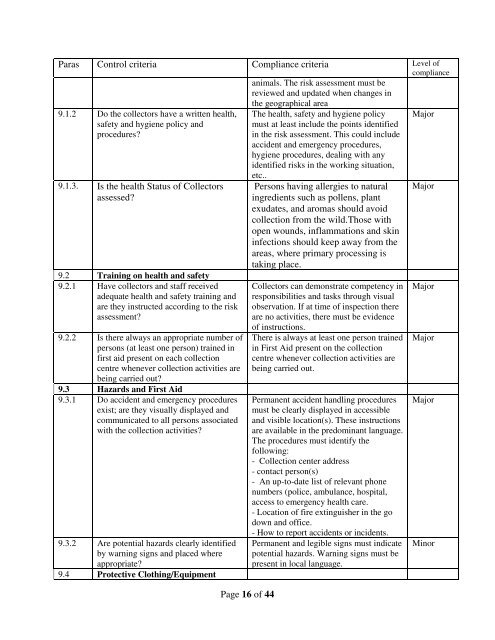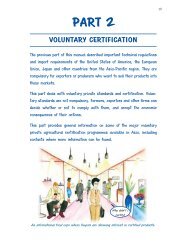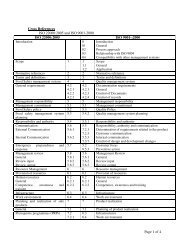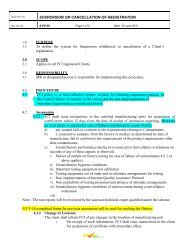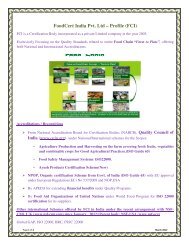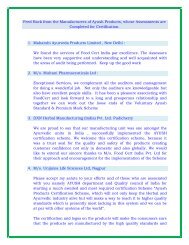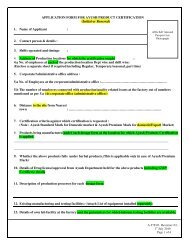Standard for Good Field Collection Practices - NMPB
Standard for Good Field Collection Practices - NMPB
Standard for Good Field Collection Practices - NMPB
You also want an ePaper? Increase the reach of your titles
YUMPU automatically turns print PDFs into web optimized ePapers that Google loves.
Paras Control criteria Compliance criteria Level of<br />
compliance<br />
animals. The risk assessment must be<br />
reviewed and updated when changes in<br />
the geographical area<br />
9.1.2 Do the collectors have a written health,<br />
safety and hygiene policy and<br />
procedures?<br />
9.1.3. Is the health Status of Collectors<br />
assessed?<br />
9.2 Training on health and safety<br />
9.2.1 Have collectors and staff received<br />
adequate health and safety training and<br />
are they instructed according to the risk<br />
assessment?<br />
9.2.2 Is there always an appropriate number of<br />
persons (at least one person) trained in<br />
first aid present on each collection<br />
centre whenever collection activities are<br />
being carried out?<br />
9.3 Hazards and First Aid<br />
9.3.1 Do accident and emergency procedures<br />
exist; are they visually displayed and<br />
communicated to all persons associated<br />
with the collection activities?<br />
9.3.2 Are potential hazards clearly identified<br />
by warning signs and placed where<br />
appropriate?<br />
9.4 Protective Clothing/Equipment<br />
Page 16 of 44<br />
The health, safety and hygiene policy<br />
must at least include the points identified<br />
in the risk assessment. This could include<br />
accident and emergency procedures,<br />
hygiene procedures, dealing with any<br />
identified risks in the working situation,<br />
etc..<br />
Persons having allergies to natural<br />
ingredients such as pollens, plant<br />
exudates, and aromas should avoid<br />
collection from the wild.Those with<br />
open wounds, inflammations and skin<br />
infections should keep away from the<br />
areas, where primary processing is<br />
taking place.<br />
Collectors can demonstrate competency in<br />
responsibilities and tasks through visual<br />
observation. If at time of inspection there<br />
are no activities, there must be evidence<br />
of instructions.<br />
There is always at least one person trained<br />
in First Aid present on the collection<br />
centre whenever collection activities are<br />
being carried out.<br />
Permanent accident handling procedures<br />
must be clearly displayed in accessible<br />
and visible location(s). These instructions<br />
are available in the predominant language.<br />
The procedures must identify the<br />
following:<br />
- <strong>Collection</strong> center address<br />
- contact person(s)<br />
- An up-to-date list of relevant phone<br />
numbers (police, ambulance, hospital,<br />
access to emergency health care.<br />
- Location of fire extinguisher in the go<br />
down and office.<br />
- How to report accidents or incidents.<br />
Permanent and legible signs must indicate<br />
potential hazards. Warning signs must be<br />
present in local language.<br />
Major<br />
Major<br />
Major<br />
Major<br />
Major<br />
Minor


